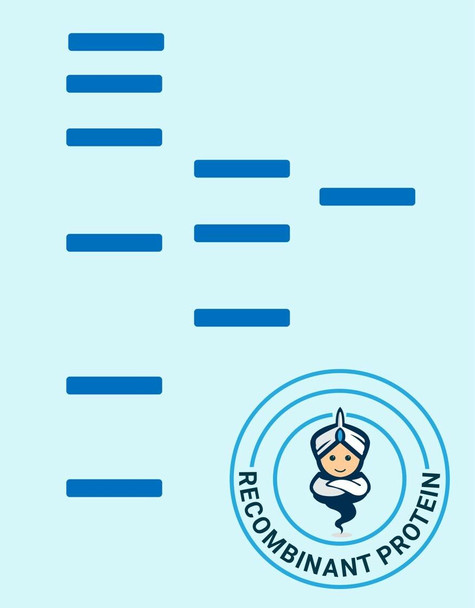Description
| Product Name: | Human UMOD Recombinant Protein |
| Product Code: | RPPB2510 |
| Size: | 10µg |
| Species: | Human |
| Target: | UMOD |
| Synonyms: | Tamm-Horsfall urinary glycoprotein, THP, FJHN, HNFJ, THGP, MCKD2, ADMCKD2, UMOD, Uromodulin. |
| Source: | Human Urine |
| Physical Appearance: | Filtered White lyophilized (freeze-dried) powder. |
| Formulation: | The UMOD protein was lyophilized from 0.4�m filtered solution at a concentration of 0.6mg/ml containing deionized water. |
| Solubility: | Add deionized water to prepare a working stock solution of approximately 0.5mg/mL and let the lyophilized pellet dissolve completely. Product is not sterile! Please filter the product by an appropriate sterile filter before using it in the cell culture. |
| Stability: | Lyophilized UMOD although stable at room temperature for 3 weeks, should be stored desiccated below -18°C. Upon reconstitution UMOD should be stored at 4°C between 2-7 days and for future use below -18°C.For long term storage it is recommended to add a carrier protein (0.1% HSA or BSA).Please prevent freeze-thaw cycles. |
| Purity: | Greater than 95.0% as determined by SDS-PAGE. |
| Amino Acid Sequence: | DTSEARWCSE CHSNATCTED EAVTTCTCQE GFTGDGLTCV DLDECAIPGA HNCSANSSCV NTPGSFSCVC PEGFRLSPGL GCTDVDECAE PGLSHCHALA TCVNVVGSYL CVCPAGYRGD GWHCECSPGS CGPGLDCVPE GDALVCADPC QAHRTLDEYW RSTEYGEGYA CDTDLRGWYR FVGQGGARMA ETCVPVLRCN TAAPMWLNGT HPSSDEGIVS RKACAHWSGH CCLWDASVQV KACAGGYYVY NLTAPPECHL AYCTDPSSVE GTCEECSIDE DCKSNNGRWH CQCKQDFNIT DISLLEHRLE CGANDMKVSL GKCQLKSLGF DKVFMYLSDS RCSGFNDRDN RDWVSVVTPA RDGPCGTVLT RNETHATYSN TLYLADEIII RDLNIKINFA CSYPLDMKVS LKTALQPMVS ALNIRVGGTG MFTVRMALFQ TPSYTQPYQG SSVTLSTEAF LYVGTMLDGG DLSRFALLMT NCYATPSSNA TDPLKYFIIQ DRCPHTRDST IQVVENGESS QGRFSVQMFR FAGNYDLVYL HCEVYLCDTM NEKCKPTCSG TRFRSGSVID QSRVLNLGPI TRKGVQATVS |
Uromodulin is the most abundant protein in normal urine. Its secretion in urine follows proteolytic cleavage of the ectodomain of its glycosyl phosphatidylinosital-anchored counterpart that is situated on the luminal cell surface of the loop of Henle. Uromodulin plays a role as a constitutive inhibitor of calcium crystallization in renal fluids. Secretion of uromodulin in urine provides protection against urinary tract infections caused by uropathogenic bacteria. Defects in Uromodulin expression are associated with the autosomal dominant renal disorders medullary cystic kidney disease-2 (MCKD2) and familial juvenile hyperuricemic nephropathy (FJHN). These disorders are characterized by juvenile onset of hyperuricemia, gout, and progressive renal failure. While several transcript variants may exist for this gene, the full-length natures of only two have been described to date. UMOD is involved in regulating the circulating activity of cytokines as it binds to il-1, il-2 and tnf with high affinity.
Uromodulin Human Native protein produced from Human Urine, is a glycosylated polypeptide chain containing 590 amino acids, having a total Mw of 64.25 kDa (excluding glycosylation).
| UniProt Protein Function: | UMOD: Uromodulin: Functions in biogenesis and organization of the apical membrane of epithelial cells of the thick ascending limb of Henle's loop (TALH), where it promotes formation of complex filamentous gel-like structure providing the water barrier permeability. May serve as a receptor for binding and endocytosis for cytokines (IL-1, IL-2) and TNF. Facilitates neutrophil migration across renal epithelial. Defects in UMOD are the cause of familial juvenile hyperuricemic nephropathy type 1 (HNFJ1). HNFJ1 is a renal disease characterized by juvenil onset of hyperuricemia, polyuria, progressive renal failure, and gout. The disease is associated with interstitial pathological changes resulting in fibrosis. Defects in UMOD are the cause of medullary cystic kidney disease type 2 (MCKD2). MCKD2 is a form of tubulointerstitial nephropathy characterized by formation of renal cysts at the corticomedullary junction. It is characterized by adult onset of impaired renal function and salt wasting resulting in end-stage renal failure by the sixth decade. Defects in UMOD are the cause of glomerulocystic kidney disease with hyperuricemia and isosthenuria (GCKDHI). GCKDHI is a renal disorder characterized by a cystic dilation of Bowman space, a collapse of glomerular tuft, and hyperuricemia due to low fractional excretion of uric acid and severe impairment of urine concentrating ability. 4 isoforms of the human protein are produced by alternative splicing. |
| UniProt Protein Details: | Protein type:Membrane protein, GPI anchor Chromosomal Location of Human Ortholog: 16p12.3 Cellular Component: apical plasma membrane; basolateral plasma membrane; extrinsic to membrane; spindle pole Molecular Function:IgG binding Biological Process: cellular defense response; heterophilic cell adhesion; leukocyte adhesion; negative regulation of cell proliferation Disease: Glomerulocystic Kidney Disease With Hyperuricemia And Isosthenuria; Hyperuricemic Nephropathy, Familial Juvenile, 1; Medullary Cystic Kidney Disease 2 |
| NCBI Summary: | The protein encoded by this gene is the most abundant protein in mammalian urine under physiological conditions. Its excretion in urine follows proteolytic cleavage of the ectodomain of its glycosyl phosphatidylinosital-anchored counterpart that is situated on the luminal cell surface of the loop of Henle. This protein may act as a constitutive inhibitor of calcium crystallization in renal fluids. Excretion of this protein in urine may provide defense against urinary tract infections caused by uropathogenic bacteria. Defects in this gene are associated with the renal disorders medullary cystic kidney disease-2 (MCKD2), glomerulocystic kidney disease with hyperuricemia and isosthenuria (GCKDHI), and familial juvenile hyperuricemic nephropathy (FJHN). Alternative splicing of this gene results in multiple transcript variants. [provided by RefSeq, Jul 2013] |
| UniProt Code: | P07911 |
| NCBI GenInfo Identifier: | 137116 |
| NCBI Gene ID: | 7369 |
| NCBI Accession: | P07911.1 |
| UniProt Secondary Accession: | P07911,Q540J6, Q6ZS84, Q8IYG0, B3KP48, B3KRN9, E9PEA4 |
| UniProt Related Accession: | P07911 |
| Molecular Weight: | 73,571 Da |
| NCBI Full Name: | Uromodulin |
| NCBI Synonym Full Names: | uromodulin |
| NCBI Official Symbol: | UMOD�� |
| NCBI Official Synonym Symbols: | THP; FJHN; HNFJ; THGP; HNFJ1; MCKD2; ADMCKD2�� |
| NCBI Protein Information: | uromodulin |
| UniProt Protein Name: | Uromodulin |
| UniProt Synonym Protein Names: | Tamm-Horsfall urinary glycoprotein; THP |
| Protein Family: | Uromodulin |
| UniProt Gene Name: | UMOD�� |
| UniProt Entry Name: | UROM_HUMAN |








